
views
Prepping Your Cabinets
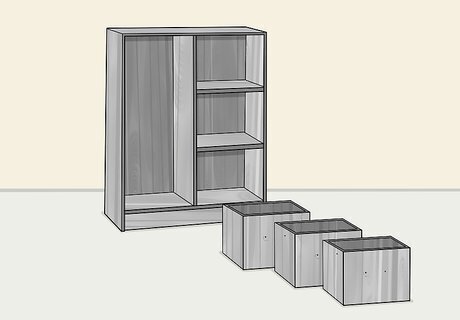
Remove your drawers and doors and label them. Start by lifting each drawer out of your cabinet by sliding it up as you pull it out. Once you’ve removed every drawer, grab a Philips or flathead screwdriver. Unscrew each bracket and fastener connecting your doors to the frame of the cabinet. As you remove each piece, label it with pencil so that you know where it goes when it comes time to reinstall the cabinets. Unscrew each handle and knob and set them aside next to their corresponding drawer or door. Set each screw and bracket next to the corresponding piece that it belongs to ensure that you don’t mix the brackets up. You can label each drawer by describing where it goes or you can assign each row a letter and number your drawers and doors. You can also draw a diagram showing where each drawer belongs to make the labeling process easier to understand. Refinishing your cabinets will likely take 4-5 days since you need to wait for each coat of primer and paint to dry.
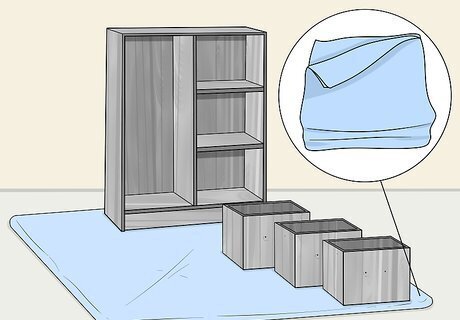
Lay a drop cloth down and set up a stable work surface. Lay a plastic or cloth drop cloth down along the edges of your cabinets to keep your floor clean while you sand, prime, and paint. Set up 2 saw horses or lay another drop cloth over your table to make painting your cabinets and drawers easier. If your cabinets sit an angle along multiple walls, use more than 1 drop cloth to cover as much of the floor as possible.
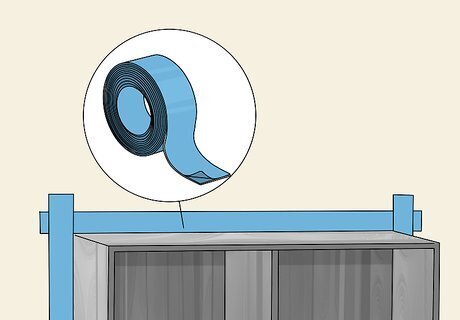
Tape off any surfaces you want to keep dry using painter’s tape. Use painter’s tape to cover any edges where the wall meets the cabinet. Pull out each length of tape and smooth it down against your wall with your palm as you apply it. Use tape to cover any sections of your cabinet or backsplash that you don’t want to paint.Tip: If you have any outlets built into your backsplash or cabinets, remove the faceplates using a screwdriver and put a piece of tape over the outlets. If you’re worried about getting paint on your countertop, lay an additional drop cloth over the counter to keep it dry.
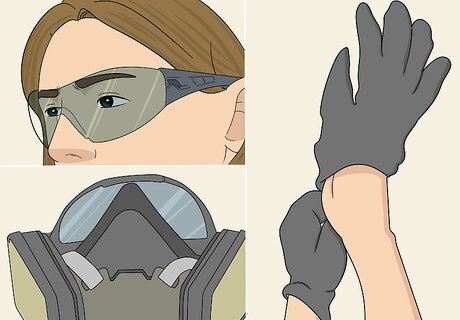
Wear a respirator, thick gloves, and protective eyewear. There will be a lot of sawdust and paint fumes floating through the air while you’re working. To keep your lungs safe, wear a respirator. Keep sawdust out of your eyes by wearing protective eyewear. Put on gloves and long-sleeved clothing to keep paint off of your skin. You don’t need to wear the respirator the entire time, but it has to be on when you’re sanding and priming to avoid irritating your lungs. You won’t need to wear it while you’re painting if you go with latex paint, but oil-based paints are typically noxious and you’ll want to wear a respirator.
Sanding and Priming the Wood

Use wood putty to repair damaged or chipped wood and let it dry. Get a can of wood putty and a putty knife. Open the wood putty and scoop some up using the blade of your putty knife. Rub the putty into your damaged surface to fill it with wood putty. Once the hole is filled, empty your putty knife and scrape the surface repeatedly to remove the excess putty. Wait 24 hours for the putty to completely harden. Repeat this process for every damaged section of your cabinet. Don’t forget about your doors and drawers! For each step in this process, repeat the action with your doors and drawers. Set them up on your sawhorses or stable work surface to sand, prime, and paint them.

Use a 120- to 180-grit sandpaper to sand your cabinets, doors, and drawers. To remove the current finish or paint, get a sheet of sandpaper. You can also use a sanding block if you prefer. Scrape each surface of your cabinets, doors, and drawers using a firm, circular stroke. Cover each area 4-5 times to expose the wood’s pores and grind away the current finish. If you aren’t repainting the insides of your cabinet, doors, and drawers, don’t sand them.Variaton: If you want to save yourself some work, get an orbital sander from your local hardware store. Attach a 120-grit disc to the sander and turn it on its lowest power setting. Then, use the disc to sand your cabinets. This will save you quite a bit of effort, but it may cost $25-100 to rent the orbital sander. Do not use an orbital sander on wood veneer panels. You don’t really need to refinish the insides of your cabinets and drawers, but you can if you want! The same applies to the undersides of your cabinet, although many people choose to refinish the undersides of the upper cabinets to make them uniform. However, if the wood underneath your upper cabinets is really thin, you may struggle to sand and paint them without cracking the wood. If you notice that your cabinets have veneer stickers on them to make them look like real wood, do not remove them. Use an 80-grit instead of 120- or 180-grit sandpaper to create a texture in the veneer. Sand them slightly softer than you normally would to avoid cracking or peeling the veneer. Other than using a softer sanding method, you do not need to treat these cabinets differently.

Vacuum the cabinets and the floor to remove any sawdust. Once you’ve sanded the cabinets, there will be a lot of sawdust. To remove it, run a cloth across each surface to rub most of the dust off. Then, turn on a vacuum with a hose attachment. Working your way from the top to the bottom, run the hose across every surface of your cabinets to remove the sawdust. You don’t have to vacuum the floor if you don’t want, but you may knock up some of the dust into your paint as it’s drying. It’s best to remove the sawdust everywhere if you can. You can use a hand vacuum instead of a hose attachment if you prefer, but it may be awkward to use on the interior edges of the cabinet.

Prime your cabinets and wait 24-48 hours for the primer to dry. Open the windows and turn a fan on to improve the ventilation in the room while you work. Fill a paint tray halfway with an oil-based primer. Load your brush and paint the edges of your cabinets and drawers using back-and-forth strokes and painting in the direction of the wood grain. Brush paint into the recessed details and engravings. Then, use a foam roller to cover the larger panels and flatter surfaces. Continue priming your cabinets, doors, and drawers until you’ve covered every surface. Wait at least 24-48 hours after applying your primer to give it time to dry. Use the foam roller on any flat sections of your cabinets. Flat sides, front panels, and narrow beams should all be painted with the roller. Use the brush to paint any section of your cabinets that you can’t use a roller to cover. You can use a spray primer if you prefer, but it will be kind of awkward to use indoors and it is difficult to keep it off of the walls and countertop.
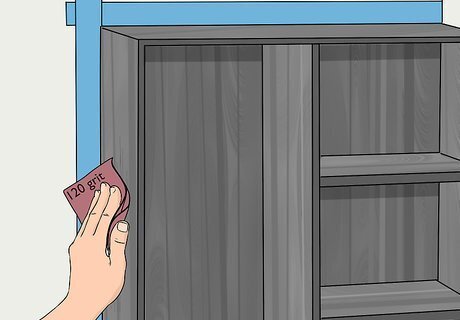
Sand the primed surfaces with an 80- to 120-grit sandpaper. Once your primer has dried, get another sanding brick or sheet of sandpaper. Repeat the sanding process by using hard, circular strokes to sand your primed surfaces. Cover each surface 4-5 times to ensure that you expose the porous wood underneath. Vacuum again after you’ve finished sanding your surfaces. You need to sand in order to ensure that your paint adheres to the wood instead of the primer. If you don’t sand, your paint job may look uneven and clunky.
Painting Your Cabinets

Fill a paint tray with your acrylic or oil-based paint. Choose an acrylic or oil-based paint based on the color and texture that you want for your top coat. Open the top of your paint with a flathead screwdriver and mix it with a mixing stick until the color is smooth and uniform. Fill a clean paint tray halfway with your paint. Acrylic paint will result in a smoother finish that doesn’t reflect light, but it tends to be harder to clean than oil-based paint. Oil-based paint is thicker than acrylic and will result in a shinier finish. It’s a lot easier to clean than acrylic paint, however, it can feel kind of sticky when you touch it. Oil paint is a good option for this project.

Paint the trim, corners, and details with an angle brush. To start, dip a 2–3 in (5.1–7.6 cm) angle brush into your paint and tap it in the tray to remove the excess paint. Apply paint to the corners and oddly-shaped edges using smooth, even strokes. Paint in the direction of the wood grain to ensure that the paint adheres to the pores of the wood. Continue painting until you’ve covered all of the edges and trim.Tip: Keep an eye on the corners of the frame at the bottom of your cabinets. They tend to accumulate paint and drip. Smooth any drips out with an unloaded brush. You can use a natural or synthetic brush. Nylon is better for smoother wood while a natural brush is better for rougher surfaces. Your brush strokes will leave a slight texture behind. You can use the brush to paint all of your cabinet’s surfaces if you want this texture. If you don’t want to leave this texture behind, paint over the edges of your brush strokes with the roller.
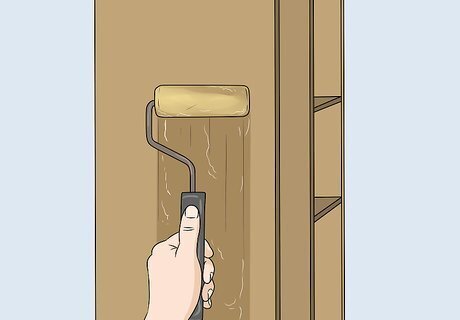
Use a foam roller to paint your panels and even surfaces. Once you’ve painted the hard-to-paint edges and corners, fill a foam roller up with your paint. Then, roll the flatter surfaces, like the panels and sides of the cabinets, using even strokes. Overlap each roll as you apply it. Cover each section 2-3 times to ensure that there are no gaps in the paint where it soaks into the pores. Continue painting until you’ve covered each surface that you’re going to paint. You can use a thick-napped roller if you prefer, but a foam roller tends to be easier to use with smooth surfaces.
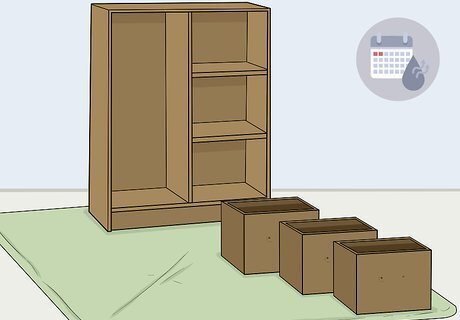
Wait 24-48 hours for your paint to dry. Once you’ve finished painting, wait for the base coat to dry. This typically takes 24 hours, but it may take slightly longer if you’re using oil-based paint or didn’t do a great job of sanding. Keep your windows open and any fans on to ensure that the fumes don’t build up in your room.
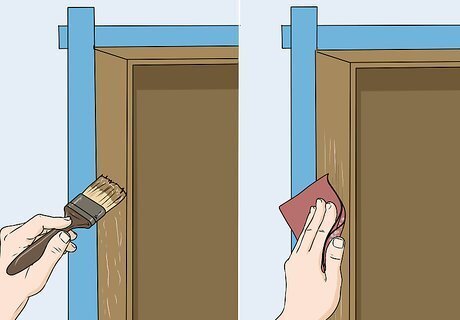
Reapply additional coats until you achieve the color that you want. Once your paint dries, inspect the finish to see if it’s consistent and even. In most cases, you’ll want to apply additional coats to make the paint uniform and the color rich. Reapply an additional 2-3 coats, waiting and sanding in between each coat to ensure that the paint adheres to the wood. If you’re painting your cabinets a bright color, you’ll definitely need multiple coats to achieve the true color of the paint. If you like a slightly uneven or textured look, feel free to stop painting after applying your base coat.

Seal your cabinets with varnish and wait 24 hours for them to dry. Once your paint job has dried, get a shellac or wood varnish if you want to waterproof the cabinets. Fill a clean paint tray with your finish and use a natural brush to apply it to the paint. Work slowly and carefully and paint in the direction of the wood grain. Use the brush to cover every surface. Wait at least 24 hours for the shellac or varnish to dry. You do not have to seal your cabinets if you don’t want to. It will help protect them over a longer period of time, though.
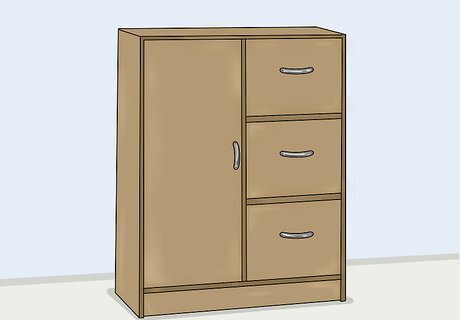
Reinstall your cabinets and drawers using your diagram and labels. Once your cabinets are painted and sealed, remove the painter’s tape. Peel it off slowly to avoid ripping up any paint if you taped sections of the cabinet off. Then, slide your drawers back into their designated tracks. Reattach each door using the corresponding brackets and a screwdriver. Once you’ve reinstalled the drawers and doors, use a screwdriver to reinstall the doorknobs and handles. If your cabinet hardware is outdated, updating it could really improve the appearance of your cabinets overall.


















Comments
0 comment